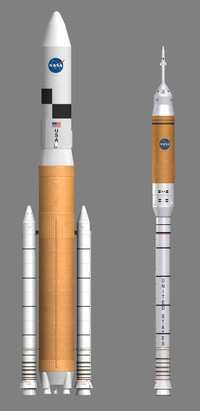First In Series Of Goals Prior To Hardware Construction
 Aero-News learned Thursday NASA has
completed the Ares I crew launch vehicle system requirements review
-- the first such milestone for a US human-rated launch vehicle
system in more than 30 years. NASA says this review brings the
agency one step closer to developing a new mode of space
transportation for astronauts on missions to explore the moon, Mars
and other destinations.
Aero-News learned Thursday NASA has
completed the Ares I crew launch vehicle system requirements review
-- the first such milestone for a US human-rated launch vehicle
system in more than 30 years. NASA says this review brings the
agency one step closer to developing a new mode of space
transportation for astronauts on missions to explore the moon, Mars
and other destinations.
"This is a critical step for development of the Ares I crew
launch vehicle," said Constellation Program manager Jeff Hanley. "A
great deal of engineering analysis and planning has culminated in a
thorough review that gives us confidence to go forward with Ares I
design work."
The system requirements review confirmed the Ares I system
requirements were complete, validated and responsive to mission
requirements. It also confirmed that the Ares I architecture and
design concept can fulfill the mission objectives and that the Ares
project is ready to begin engineering design activities.
The Ares preliminary design review is scheduled for
mid-2008.
This review is the first in a series of milestones that will
occur before the actual flight hardware is built. Each major review
provides more detailed requirements for the vehicle design to
ensure the overall system can meet all NASA requirements for safe
and reliable flight. The review process also identifies technical
and management challenges, and addresses ways to reduce potential
risks as the project goes forward.
"The successful completion of this first review is the
culmination of a lot of hard work and long hours by many people
around the country by our government and industry team," said Steve
Cook, manager of the Exploration Launch Projects Office at NASA's
Marshall Space Flight Center. "The result of their tireless efforts
is that the board confirmed that we have a good, stable set of
requirements to start the design phase of Ares I."
Among the items addressed in the review was the commitment to
reduce operations costs through streamlined launch vehicle
processing. All hardware elements - the first stage, upper stage
and upper stage engine - are emphasizing operations simplicity to
enable NASA to sustain long-term exploration of space within its
budget.
The review follows a series of successful system requirements
reviews for the Ares launch vehicle project, including for the J-2X
engine, Ares I first stage and Ares I-1 test flight. The J-2X
engine will power the upper stage of Ares I, as well as the Ares V
Earth departure stage that will propel Orion from Earth orbit to
the moon late next decade.
Ares I-1, planned for launch in 2009, will be the first test
flight of the integrated launch vehicle system.
In January 2007, the Ares project will begin the second in a
series of design analyses cycles leading to final design and
fabrication of the launch vehicle. This cycle will baseline design
changes made during the first cycle.
I
 n the updated Ares 1
configuration, a common bulkhead between the upper stage liquid
hydrogen and liquid oxygen tanks has been substituted for an
intertank, thus shortening the vehicle. The thrust profile for the
Ares I first stage also has been baselined. This means requirements
have been established for how the solid propellant inside the
five-segment reusable solid rocket booster burns during ascent.
n the updated Ares 1
configuration, a common bulkhead between the upper stage liquid
hydrogen and liquid oxygen tanks has been substituted for an
intertank, thus shortening the vehicle. The thrust profile for the
Ares I first stage also has been baselined. This means requirements
have been established for how the solid propellant inside the
five-segment reusable solid rocket booster burns during ascent.
The Constellation Program, located at NASA's
Johnson Space Center in Houston, has overall responsibility for
development of the crew exploration and launch vehicles and related
systems in support of NASA exploration missions to extend a human
presence throughout the solar system.
The Exploration Launch Projects Office at NASA's Marshall Space
Flight Center in Huntsville, AL is responsible for design and
development of the Ares I crew and Ares V cargo launch vehicles.
Johnson is responsible for development of the Orion capsule and
mission operations. NASA's Kennedy Space Center in Florida is
responsible for ground and launch operations. The program also
includes multiple project element teams at NASA centers and
contract organizations around the nation.
 ANN's Daily Aero-Linx (05.02.24)
ANN's Daily Aero-Linx (05.02.24) ANN's Daily Aero-Term (05.02.24): Touchdown Zone Lighting
ANN's Daily Aero-Term (05.02.24): Touchdown Zone Lighting Aero-News: Quote of the Day (05.02.24)
Aero-News: Quote of the Day (05.02.24) ANN FAQ: Contributing To Aero-TV
ANN FAQ: Contributing To Aero-TV NTSB Final Report: Cirrus Design Corp SR20
NTSB Final Report: Cirrus Design Corp SR20




